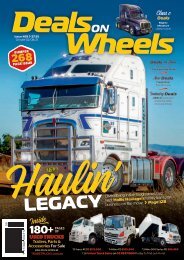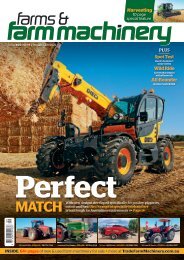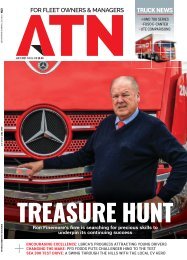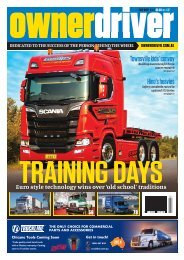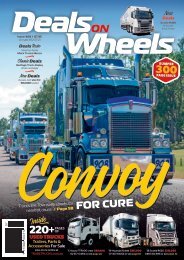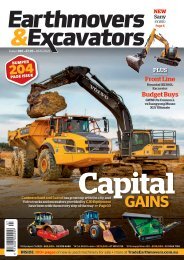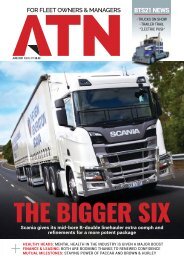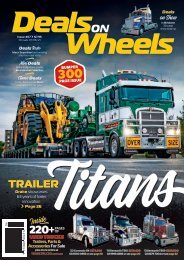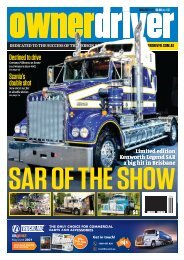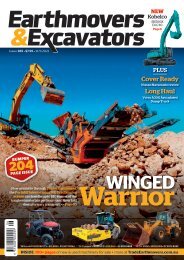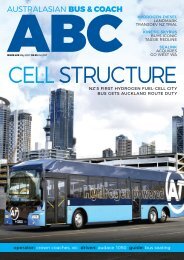ABC #397
You also want an ePaper? Increase the reach of your titles
YUMPU automatically turns print PDFs into web optimized ePapers that Google loves.
COVERSTORY<br />
FOTON FUEL CELL<br />
FOTON IN<br />
AUSTRALIA<br />
In August 1996, Foton set out to<br />
become a leading player in the<br />
world’s largest and most demanding<br />
logistics market, China, it states.<br />
To do this it had to be different from<br />
the competition and provide a worldclass<br />
alternative product solution for<br />
both logistics operators and drivers,<br />
it says.<br />
According to the company, it<br />
believes: “…that technology is the soul<br />
and DNA of the automobile”, and<br />
that its guiding principle became:<br />
‘Technology leading into the future’.<br />
As it explains of its truck division, it<br />
set about establishing strategic joint<br />
ventures with the ‘best of the best’<br />
in the commercial vehicle industry.<br />
Foton’s three key strategic alliances<br />
have allowed access to global<br />
technological insights from:<br />
• Cummins, a global icon in the<br />
heavy-duty truck market and the<br />
world’s largest independent engine<br />
manufacturer;<br />
• Germany’s Daimler Group, the<br />
world’s largest manufacturer of<br />
premium commercial vehicles;<br />
• ZF, the world’s largest supplier<br />
of transmission and chassis<br />
technology.<br />
In terms of bus, Foton shares a<br />
unique relationship with Toyota and<br />
its fuel-cell technology.<br />
Foton operates R&D centres in<br />
China, Germany and Japan and has<br />
garnered the combined efforts of<br />
6,500 engineers from more than 40<br />
countries and witnessed 5,000 R&D<br />
patents, it explains.<br />
mortals based on atomic number and<br />
weight, electron configurations and<br />
various other chemical characteristics.<br />
Elements ‘of a feather stick together’,<br />
as it were. And of the lot, snaring first<br />
place with atomic number ‘numero<br />
uno’ is the lightest and most common<br />
element in the universe of them all –<br />
hydrogen!<br />
Since its discovery in 1671 and<br />
the following 90 years of tests and<br />
experiments to learn it ultimately<br />
produces water when it burns, it’s<br />
been used purposefully for many key<br />
industrial revolution technological<br />
advancements, such as for its light<br />
lift properties in iconic air-travel<br />
balloons first invented in 1783 – ending<br />
effectively with the infamous 1937<br />
Hindenburg disaster – and later closer<br />
to the ground in 1806’s de Rivaz<br />
internal combustion engine.<br />
Notably, towards the end of that<br />
era, the first hydrogen fuel-cell was<br />
invented in 1838, where - explained<br />
in rudimentary terms - hydrogen and<br />
oxygen react to produce electricity,<br />
with the by-product being water.<br />
And it is in that fundamental<br />
concept that modern-day buses – like<br />
we would have seen in use during<br />
the 2020 Tokyo Olympic Games – cars<br />
and trucks are evolving as a seemingly<br />
environmentally cleaner alternative to<br />
traditional petrol and diesel vehicles.<br />
PUBLIC TRANSPORT<br />
“Our hydrogen and electric bus will<br />
available in both Australia and New<br />
Zealand. Both the Foton Australia and<br />
New Zealand teams will work together<br />
to provide the after-sales support<br />
36<br />
<strong>ABC</strong> September 2020 busnews.com.au




